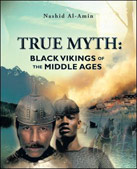"The masses of humanity that flowed out of Africa have been black-skinned, and common sense should tell us that earliest man must have remained so for many millennia after he reached various territories in Europe, Asia, Australia, and the Americas."

 |
True Myth: Black Vikings of the Middle Ages by Nashid Al-Amin Trafford Publishing
book review by Caroline Blaha-Black
The author makes a strong case that the Vikings of the Middle Ages, also called Norsemen or Scandinavians, were not white, as originally thought, but black or with a dark complexion. The gist of the book concentrates on the racial origins and makeup of the Vikings, whom most people think of as the members of the Caucasian race.
The book is a lengthy, scholarly work, and the author goes into great detail about the ancient world, with the first true man coming out of east Africa and populating the world during the Old Stone Age. He argues that the early Grimaldi man (black, Australoid type) preceeded the Cro Magnon man. The author postulates that genetic mutation known as albinism within the Grimaldi society might have created the white individuals of which the white Europeans are ancestors today.
The book also goes into great detail on the Vikings, starting with the Danes, also known as the Cimbri, who were most prominent in Denmark, Norway, and Sweden in the 7th century. These were oftentimes referred to as "black-skinned," or "black strangers," and the author presents quotes as evidence from various historians. Several notable Viking chieftans are listed as having dark or black complexion, notably the famous Olaf Haraldsson and Halfdan the Black. Interesting to note is the term "grim," which was attached to a lot of the Viking names; the author postulates that it denotes a black person.
The author documents his work with numerous quotes from Nordic sagas and various historians, and invites the reader to keep an open mind and reach their own conclusion. Pictures of various artifacts are presented to denote black features, as in the Willendorf Venus or in the carving of the Norse God of thunder, Thor. Also, there is an extensive list of cited works at the back for the reader to peruse. In addition, the author takes on an inquisitive tone which tends to be rather cynical at times. This is a great book to read for anyone who is interested in the Vikings or in an alternative portrayal of Norse history.